Job Openings Come In Much Hotter Than Expected Despite Continued Deterioration In Hiring
One month after the October JOLTS report signaled a long-overdue plunge in job openings, when the BLS reported a 353,000 drop and reversing much of the previous month's gain, things have again reverted back to normal because the latest JOLTS reported indicated that after the strong upward revised October print of 10.512MM - up from 10.334MM previously -the latest, November, openings print was 10.458MM, which while a drop of 54K from the previous month, was more than 400K higher than consensus expectations.

This was the third consecutive beat of expectations in the series, and an unprecedented 11 of the past 12 prints, just another garden variety six-sigma event by the never political BLS.
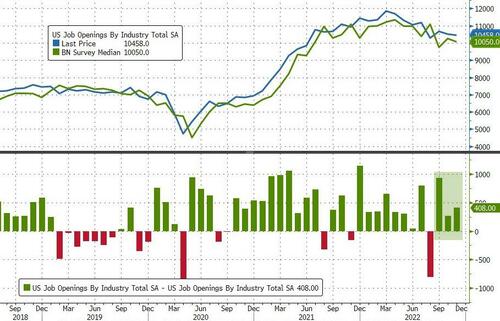
According to the BLS, in November, job openings increased in professional and business services (+212,000) and in nondurable goods manufacturing (+39,000). The number of job openings decreased in finance and insurance(-75,000) and in federal government (-44,000).
The latest surge in job openings means that for the 2nd consecutive month there are 4.4 million more jobs than unemployed workers...
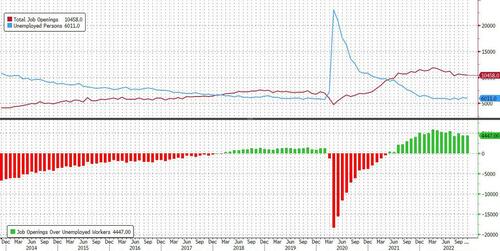
Said otherwise, there were 1.74 job openings for every unemployed worker, unchanged from last month. Needless to say, this number has a ways to drop to revert to its precovid levels around around 1.20...
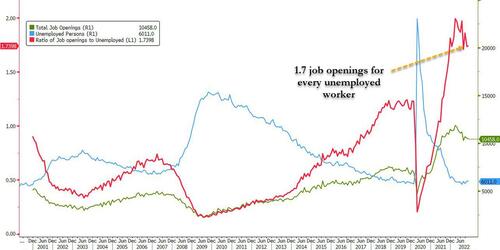
... and as Nick Timiraos writes, "the Fed would like to see the ratio of vacancies to unemployed workers decline. It’s holding around 1.75"
The number of job openings stood at 10.5 million on the last business day of November, unchanged from October (which initially was at 10.3 million)
— Nick Timiraos (@NickTimiraos) January 4, 2023
The Fed would like to see the ratio of vacancies to unemployed workers decline. It’s holding around 1.75 https://t.co/4LtyfijE6z
While job openings unexpectedly reversed the recent drop and keep coming hotter than expected, hiring continued to slide and in November the BLS reported that total hires dipped to 6.0552 million which was the lowest since February 2021.

The trend here is clear: lower and to the right. According to the BLS, hires increased in health care and social assistance (+74,000).
Meanwhile, in yet another surprising reversal, the number of quits - or the "take this job and shove it" indicator - unexpectedly rose and in November jumped by 126K to 4,173MM, the biggest increase since November 2021.
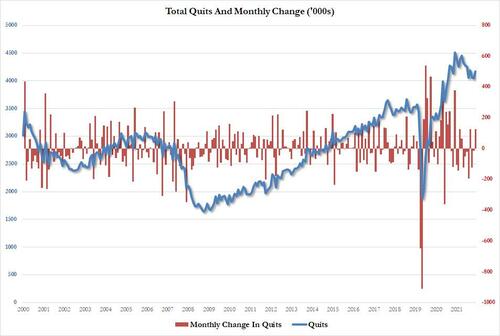
So what's going on here, and why the chronic "beats" in job openings? Well, here is a long-term chart showing new hires vs quits. Whereas traditionally the two data sets would correlate, in the past year we have seen far more quits than the number of hires would suggest, which in turn leads to more cumulative job openings.
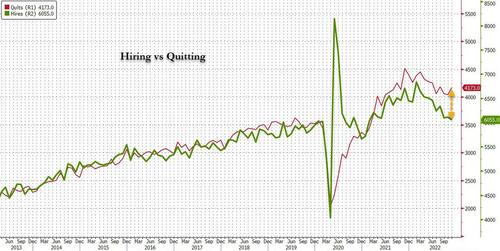
The prepondrancy of quitting is confirmed by Nick Bunker, economist at @indeed, who also observes that "the big story from this report is that quitting is no longer slowing down. The labor market is still giving lots of workers lots of opportunities to take new jobs. Hard to see a more significant moderation of wage growth without a coldown in quitting" (the full thread is quite informative).
The big story from this report is that quitting is no longer slowing down. The labor market is still giving lots of workers lots of opportunities to take new jobs.
— Nick Bunker (@nick_bunker) January 4, 2023
Hard to see a more significant moderation of wage growth without a cooldown in quitting. pic.twitter.com/KaVSMhODjA
However, it remains unclear what all those people who quit end up doing since we know they haven't been hired or else the number of hires would also come in much hotter. On the other hand, it may all just be a statistical plug in some BLS spreadsheet to make it all foot to the jobs number.
And speaking of jobs, since the JOLTS report was for November, it is largely meaningless: what matters is what the dept of labor reveals about the number of jobs added in December, and if the continued deterioration in hiring is any indication, it won't be pretty.
More By This Author:
St. Louis Fed Quietly Finds U.S. Is Now In A Recession"An Awful Year": The Best And Worst Performing Assets Of December, Q4 And 2022
US Inflation: How Much Have Prices Increased In 2022?
Disclosure: Copyright ©2009-2022 ZeroHedge.com/ABC Media, LTD; All Rights Reserved. Zero Hedge is intended for Mature Audiences. Familiarize yourself with our legal and use policies every time ...
more


